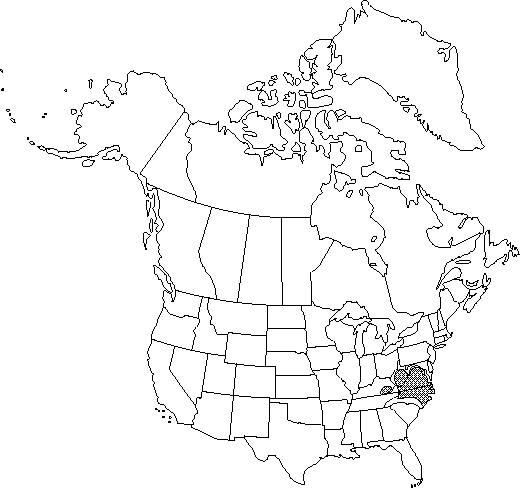Difference between revisions of "Hexastylis virginica"
Fl. S.E. U.S., 1131. 1903.
FNA>Volume Importer |
imported>Volume Importer |
||
| (7 intermediate revisions by 2 users not shown) | |||
| Line 11: | Line 11: | ||
|label=Endemic | |label=Endemic | ||
}} | }} | ||
| − | |basionyms={{Treatment/ID/ | + | |basionyms={{Treatment/ID/Basionym |
|name=Asarum virginicum | |name=Asarum virginicum | ||
|authority=Linnaeus | |authority=Linnaeus | ||
| + | |rank=species | ||
| + | |publication_title=Sp. Pl. | ||
| + | |publication_place=1: 442. 1753 | ||
}} | }} | ||
|synonyms={{Treatment/ID/Synonym | |synonyms={{Treatment/ID/Synonym | ||
|name=Asarum memmingeri | |name=Asarum memmingeri | ||
|authority=Ashe | |authority=Ashe | ||
| − | }}{{Treatment/ID/Synonym | + | |rank=species |
| + | }} {{Treatment/ID/Synonym | ||
|name=Hexastylis memmingeri | |name=Hexastylis memmingeri | ||
|authority=(Ashe) Small | |authority=(Ashe) Small | ||
| + | |rank=species | ||
}} | }} | ||
|hierarchy=Aristolochiaceae;Hexastylis;Hexastylis virginica | |hierarchy=Aristolochiaceae;Hexastylis;Hexastylis virginica | ||
| Line 29: | Line 34: | ||
}}<!-- | }}<!-- | ||
| − | --><span class="statement" id="st- | + | --><span class="statement" id="st-undefined" data-properties=""><b>Rhizomes:</b> internodes short, leaves crowded at rhizome apex. <b>Leaf</b> blade variegate or not, cordate, subcordate, or subreniform. <b>Flowers</b>: calyx tube cylindric to narrowly cylindric-urceolate, sometimes with prominent transverse ridge just below sinuses, 8-15 × 6-12 mm, inner surface with high reticulations, lobes erect or weakly spreading, 2-4 × 7-9 mm, adaxially puberulent; stamen connective not extending beyond pollen sacs; ovary ca. 1/3-inferior; ovules 8 per locule; styles notched at apex. <b>2n</b> = 26.</span><!-- |
-->{{Treatment/Body | -->{{Treatment/Body | ||
| Line 36: | Line 41: | ||
|elevation=0-700 m | |elevation=0-700 m | ||
|distribution=Ky.;Md.;N.C.;Tenn.;Va.;W.Va. | |distribution=Ky.;Md.;N.C.;Tenn.;Va.;W.Va. | ||
| − | |discussion=<p>Plants of Hexastylis virginica with small, cylindric-urceolate calices have been treated as a distinct species, H. memmingeri. The two calyx types are often found in the same population, however, so H. memmingeri seems unworthy of taxonomic recognition at any rank.</p><!-- | + | |discussion=<p>Plants of <i>Hexastylis virginica</i> with small, cylindric-urceolate calices have been treated as a distinct species, H. memmingeri. The two calyx types are often found in the same population, however, so H. memmingeri seems unworthy of taxonomic recognition at any rank.</p><!-- |
| − | --><p>Prior to the study by H. L. Blomquist (1957), many botanists interpreted Hexastylis virginica in a very broad sense, so old herbarium specimens of many other species of Hexastylis are often annotated as H. virginica.</p><!-- | + | --><p>Prior to the study by H. L. Blomquist (1957), many botanists interpreted <i>Hexastylis virginica</i> in a very broad sense, so old herbarium specimens of many other species of <i>Hexastylis</i> are often annotated as <i>H. virginica</i>.</p><!-- |
| − | --><p>The Cherokee used Hexastylis virginica medicinally to stop blood from passing (D. E. Moerman 1986, as Asarum virginicum).</p> | + | --><p>The Cherokee used <i>Hexastylis virginica</i> medicinally to stop blood from passing (D. E. Moerman 1986, as <i>Asarum</i> virginicum).</p> |
|tables= | |tables= | ||
|references= | |references= | ||
| Line 47: | Line 52: | ||
-->{{#Taxon: | -->{{#Taxon: | ||
name=Hexastylis virginica | name=Hexastylis virginica | ||
| − | |||
|authority=(Linnaeus) Small | |authority=(Linnaeus) Small | ||
|rank=species | |rank=species | ||
| Line 62: | Line 66: | ||
|publication year=1903 | |publication year=1903 | ||
|special status=Endemic | |special status=Endemic | ||
| − | |source xml=https:// | + | |source xml=https://bitbucket.org/aafc-mbb/fna-data-curation/src/2e0870ddd59836b60bcf96646a41e87ea5a5943a/coarse_grained_fna_xml/V3/V3_593.xml |
|genus=Hexastylis | |genus=Hexastylis | ||
|species=Hexastylis virginica | |species=Hexastylis virginica | ||
| − | |||
| − | |||
| − | |||
| − | |||
| − | |||
| − | |||
| − | |||
| − | |||
| − | |||
| − | |||
| − | |||
| − | |||
| − | |||
| − | |||
| − | |||
| − | |||
}}<!-- | }}<!-- | ||
-->[[Category:Treatment]][[Category:Hexastylis]] | -->[[Category:Treatment]][[Category:Hexastylis]] | ||
Latest revision as of 22:50, 5 November 2020
Rhizomes: internodes short, leaves crowded at rhizome apex. Leaf blade variegate or not, cordate, subcordate, or subreniform. Flowers: calyx tube cylindric to narrowly cylindric-urceolate, sometimes with prominent transverse ridge just below sinuses, 8-15 × 6-12 mm, inner surface with high reticulations, lobes erect or weakly spreading, 2-4 × 7-9 mm, adaxially puberulent; stamen connective not extending beyond pollen sacs; ovary ca. 1/3-inferior; ovules 8 per locule; styles notched at apex. 2n = 26.
Phenology: Flowering spring (Apr–Jun).
Habitat: Deciduous and mixed deciduous-conifer forests
Elevation: 0-700 m
Distribution

Ky., Md., N.C., Tenn., Va., W.Va.
Discussion
Plants of Hexastylis virginica with small, cylindric-urceolate calices have been treated as a distinct species, H. memmingeri. The two calyx types are often found in the same population, however, so H. memmingeri seems unworthy of taxonomic recognition at any rank.
Prior to the study by H. L. Blomquist (1957), many botanists interpreted Hexastylis virginica in a very broad sense, so old herbarium specimens of many other species of Hexastylis are often annotated as H. virginica.
The Cherokee used Hexastylis virginica medicinally to stop blood from passing (D. E. Moerman 1986, as Asarum virginicum).
Selected References
None.